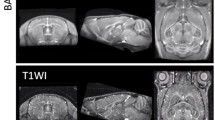Abstract
The effects of the nonpseudoautosomal region of the Y chromosome (YNPAR) on hippocampal morphology have been investigated in the inbred mouse strains NZB/B1NJ and CBA/H, using comparisons between the two parentals and their respective congenics N.H-YNPAR and H.N-YNPAR. Results obtained depend upon the hippocampal variable measured. YNPAR had no effect on the sizes of the stratum oriens, hilus, or mossy fiber terminal fields (both suprapyramidal and intra- and infrapyramidal). However, in interaction with the strain background, it affected the strata lacunosum-moleculare, radiatum, and pyramidale. Possible relationships among gene(s), mossy fiber terminal fields, and intermale aggression are discussed.
Similar content being viewed by others
References
Adams, D. B. (1980). Motivational systems of agonistic behavior in muroid rodents: A comparative review and neural model.Aggr. Behav. 6:295–346.
Barber, R. P., Vaughn, J. E., Wimer, R. E., and Wimer, C. C. (1974). Genetically-associated variations in the distribution of dentate granule cell synapses upon the pyramidal cell dendrites in mouse hippocampus.J. Comp. Neurol. 156:417–434.
Carlier, M., and Roubertoux, P. L. (1986). Differences between CBA/H and NZB mice on intermale aggression. In Médioni, J., and Vaysse, G. (eds.),Genetic Approaches to Behavior, Privat, Toulouse, pp. 47–57.
Crusio, W. E., Genthner-Grimm, G., and Schwegler, H. (1986). A quantitative-genetic analysis of hippocampal variation in the mouse.J. Neurogenet. 3:203–214.
Crusio, W. E., Schwegler, H., and Brust, I. (1993). Covariations between hippocampal mossy fibres and working and reference memory in spatial and non-spatial radial maze tasks in mice.Eur. J. Neurosci. 5:1413–1420.
Danscher, G., and Zimmer, J. (1978). An improved Timm sulphide silver method for light and electron microscopic localization of heavy metals in biological tissues.Histochemistry 55:27–40.
Eichenbaum, H., Otto, T., and Cohen, N. J. (1994). Two functional components of the hippocampal memory system.Behav. Brain Sci. 17:449–518.
Green, E. L. (1966). Breeding systems. In Green, E. L. (ed.),Biology of the Laboratory Mouse, 2nd ed., McGraw-Hill, New York, pp. 11–22.
Guillot, P.-V., Roubertoux, P. L., Carlier, M., Phillips, J., Caboche, J., Rogard, M., and Chapouthier, G. (1993). Y chromosome, GAD activity in the olfactory bulbs, and intermale aggression in mice.Behav. Genet. 23:552–553.
Guillot, P.-V., Roubertoux, P. L., and Crusio, W. E. (1994). Hippocampal mossy fiber distributions and intermale aggression in seven inbred mouse strains.Brain Res. 660: 167–169.
Hensbroek, R. A., Sluyter, F., Guillot, P.-V., van Oortmerssen, G. A., and Crusio, W. E. (1995). Y chromosomal effects on hippocampal mossy fiber distributions in mice selected for aggression.Brain Res. 682:203–206.
Lemaire, M., Barnéoud, P., Böhme, G. A., Piot, O., Haun, F., Roques, B. P., and Blanchard, B. P. (1994). CCK-A and CCK-B receptors enhance olfactory recognition via distinct neuronal pathways.Learn. Memory 1:153–164.
Moutier, R., and Carlier, M. (1991). Mandible shape analysis in Y-congenic strains of mice.Lab. Anim. 25:303–307.
Roubertoux, P. L., Carlier, M., Degrelle, H., Haas-Dupertuis, C., Phillips, J., and Moutier, R. (1994). Co-segregation of intermale aggression with the pseudoautosomal region of the Y chromosome in mice.Genetics 136:225–230.
SAS Institute Inc. (1987).SAS/STAT Guide for Personal Computers, Version 6 Edition, SAS Institute, Cary, NC.
Schwegler, H., and Lipp, H.-P. (1983). Hereditary covariations of neuronal circuitry and behavior: Correlations between the proportions of hippocampal synaptic fields in the regio inferior and two-way avoidance in mice and rats.Behav. Brain Res. 7:1–38.
Sluyter, F., Jamot, L., Van Oortmerssen, G. A., and Crusio, W. E. (1994a). Hippocampal mossy fiber distributions in mice selected for aggression.Brain Res. 646:145–148.
Sluyter, F., Van Oortmerssen, G. A., and Koolhaas, J. M. (1994b). Studies on wild house mice. VI. Differential effects of the Y chromosome on intermale aggression.Aggr. Behav. 20:379–387.
Van Oortmerssen, G. A., and Sluyter, F. (1994). Studies on wild house mice. V. Aggression in lines selected for attack latency and their Y-chromosomal congenics.Behav. Genet. 24:73–78.
Wahlsten, D., Lassalle, J.M., and Bulman-Fleming, B. (1991). Hybrid vigour and maternal environment in mice. III. Hippocampal mossy fibres and behaviour.Behav. Process. 23:47–57.
Author information
Authors and Affiliations
Rights and permissions
About this article
Cite this article
Guillot, PV., Sluyter, F., Laghmouch, A. et al. Hippocampal morphology in the inbred mouse strains NZB and CBA/H and their reciprocal congenics for the nonpseudoautosomal region of the Y chromosome. Behav Genet 26, 1–5 (1996). https://doi.org/10.1007/BF02361153
Received:
Accepted:
Issue Date:
DOI: https://doi.org/10.1007/BF02361153




